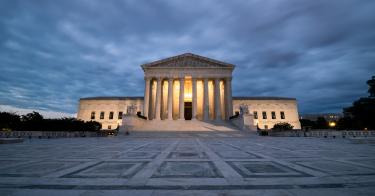Things have certainly changed since John Jay was confirmed to be the chief justice of the U.S. Supreme Court on September 26, 1789—just two days after the Senate receied his nomination.
And John Paul Stevens was confirmed 19 days after his nomination in 1975.
Even Ruth Bader Ginsburg was confirmed within 42 days in a lopsided vote of 96 to 3 on August 3, 1993.
The nasty, no-holds-barred political fights we have experienced with recent Supreme Court nominations is a relatively new occurrence, one that started with the failed nomination of Judge Robert Bork in 1987.
The main reason for this has been the very anti-democratic view of the left that the courts are the way to get around their inability to implement their economic, social, and cultural policies through the legislative process. This makes these seats very important to their political goals.
>>> SCOTUS 101: A weekly podcast that breaks down what's happening at the Supreme Court
Liberal justices have led this intrusion of the court into the legislative process. Those justices have pushed the court to go beyond applying existing law and the Constitution.
They have chosen to act, with considerable success, as a super-legislative body that rewrites, changes, or even ignores the text when necessary to achieve particular policy goals that fit the ideological beliefs of those justices.
That includes creating “rights” that don’t exist in the Constituion, or simply ignoring rights the justices don’t want to enforce, like the Second Amendment.
For most of the liberal justices on the court, the Bill of Rights jumps directly from the First Amendment to the Third Amendment, with nothing in between.
Because the court has had an almost even ideological split for decades, this has made any empty seat the subject of a fierce political battle, as we have witnessed in the firestorm ignited by the passing of Justice Ginsburg.
Although Republican appointees on the court–the generally more conservative justices—hold a five-member majority, this majority has been ephemeral at times as justices have voted with the liberals on important cases. Funny how it rarely seems to go the other way.
For a long time, the so-called swing vote was usually Justice Anthony Kennedy—nominated by Ronald Reagan—who left the court in 2018.
Unfortunately, since Kennedy’s retirement Chief Justice John Roberts seems to have adopted his habit of often joining the liberal bloc on cases involving politically and socially controversial issues.
Other justices also occasionally step into that role, like Justice Neil Gorsuch (joined by the chief justice) in Bostock v. Clayton County, where he rewrote Title VII of the Civil Rights Act of 1964 to include sexual orientation and gender identity in the definition of sex.
Roberts was the swing vote in 2012 when he joined the four liberal justices to uphold the Affordable Care Act, better known as Obamacare, in NFIB v. Sibelius, where he rewrote federal law to turn a “penalty” into a “tax” to uphold the constitutionality of the federal healthcare mandate under the taxing power of Congress.
If there had been one additional conservative on the court willing to apply the actual text of the law, thus joining the dissenters—Justice Scalia, Thomas, Alito, and Kennedy—their dissents would have become the majority opinion, throwing out Obamacare as far beyond the power of Congress under the Constitution.
The very same conduct occurred last year when Roberts joined the liberal bloc in preventing the Trump administration from adding a citizenship question to the 2020 census.
Roberts joined the liberal bloc again this year to prevent the Trump administration from ending the Deferred Action for Childhood Arrivals program, an unlawful administrative amnesty implemented by the Obama administration without congressional approval.
If there had been another conservative textualist on the court to vote with the dissenters in both of these decisions, we would have a citizenship question on the census form and the DACA program would be over, even with Roberts joining Justice Breyer, Sotomayor, and Kagan.
That would have been the right result—not because it is the best public policy outcome, but because that would have been the correct result under the applicable law.
The seat left open by the passing of Ginsburg is so important because certain justices, most often the chief justice, sometimes cross over to vote within the liberal bloc in decisions that are wrongly decided from a legal point of view, not necessarily a policy point of view.
The court’s role is not to determine if a law passed by Congress is a good or bad law. Its job is to determine whether the law was within the power of Congress to pass.
As Scalia once said, “It is entirely possible for a law to be really, really stupid and yet be constitutional.”
This piece originally appeared in NewsMax




